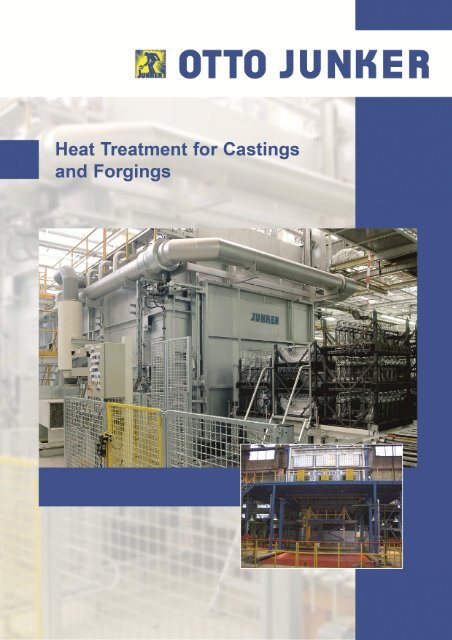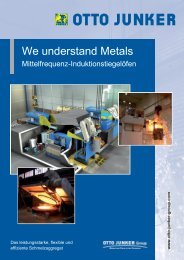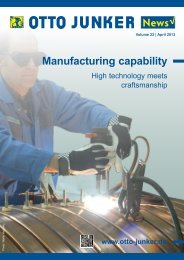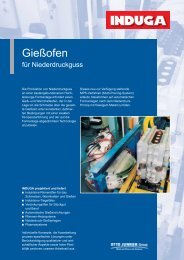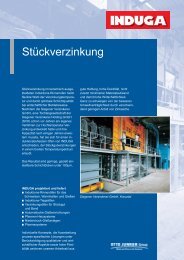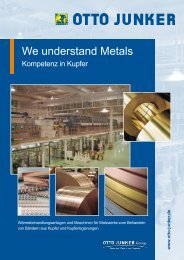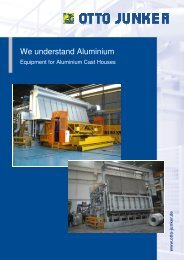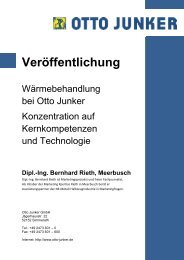Download Brochure Heat Treatment for Castings and Forgins 2012
Download Brochure Heat Treatment for Castings and Forgins 2012
Download Brochure Heat Treatment for Castings and Forgins 2012
Create successful ePaper yourself
Turn your PDF publications into a flip-book with our unique Google optimized e-Paper software.
Manufacturing Range<br />
Furnace Systems <strong>for</strong> Aluminium<br />
<strong>Castings</strong> <strong>and</strong> Forgings<br />
OTTO JUNKER supplies all necessary heat treatment, melting <strong>and</strong> holding furnaces <strong>for</strong> the entire casting <strong>and</strong><br />
<strong>for</strong>ging workflow, including foundry, hot-rolling, cold-rolling <strong>and</strong> foil-rolling applications:<br />
Our company is noted <strong>for</strong> its extensive operating experience in all heat treatment technologies required in the<br />
aluminium industry – from efficient pre-heating furnaces <strong>for</strong> <strong>for</strong>ging applications to complete heat treatment lines<br />
<strong>for</strong> wheels, cylinder heads, engine blocks, suspension components, etc.<br />
These systems are available either <strong>for</strong> fully automatic continuous operation or <strong>for</strong> discontinuous batch operation.<br />
Cooperation with other furnace manufacturers is an option, depending on the furnace type.<br />
All systems are developed, designed, delivered, installed <strong>and</strong> commissioned by OTTO JUNKER experts from<br />
the respective disciplines (sometimes jointly with our cooperation partners).<br />
Furthermore, OTTO JUNKER builds all requisite ancillary equipment <strong>and</strong> h<strong>and</strong>ling systems <strong>for</strong> these furnaces,<br />
e.g., loading or unloading manipulators <strong>and</strong> conveyor systems.<br />
The entire process responsibility rests with OTTO JUNKER's highly skilled specialists. For every product, we<br />
have an expert team covering all fields of specialization.<br />
OTTO JUNKER is committed to the objective of supplying its customers with high-grade technology. Energy<br />
efficiency <strong>and</strong> environmental compatibility are among our first <strong>and</strong> <strong>for</strong>emost concerns, in addition to our ongoing<br />
pursuit of improvements in power consumption, process management <strong>and</strong> general equipment design.<br />
All equipment types embody the latest state of the art, whether in flow management, heating technology,<br />
enclosure design <strong>and</strong> mechanical engineering. For the customer, these benefits translate into high plant<br />
availability <strong>and</strong> low maintenance <strong>and</strong> operating costs – needless to say, in conjunction with low energy<br />
consumption <strong>and</strong> ultra-close temperature tolerances.<br />
2 / 12
Development<br />
Advanced simulation methods are used to maximize the heat transfer <strong>and</strong> temperature uni<strong>for</strong>mity levels while<br />
reducing flow losses. Our clients will thus benefit from reliable, long-lived equipment based on rugged <strong>and</strong><br />
dependable OTTO JUNKER design.<br />
Following their successful engineering, mechanical <strong>and</strong> flow model validation, new technologies are subjected to<br />
hot <strong>and</strong> cold trials in the test-bay be<strong>for</strong>e being refined <strong>and</strong> progressed to production maturity.<br />
Illustrations: Numeric flow modelling aimed at achieving absolute temperature homogeneity in practice<br />
Flow-optimized heat treatment system<br />
Flow-optimized heat treatment system<br />
After-sales service<br />
OTTO JUNKER's after-sales departments rely on experienced installation supervisors, electricians <strong>and</strong> software<br />
specialists trained <strong>for</strong> worldwide on-site assignments.<br />
Apart from the supply of spare parts <strong>and</strong> classic support services such as the inspection <strong>and</strong> maintenance of<br />
existing installations, our range includes equipment overhauls, upgrades <strong>and</strong> revamps. Such conversions are<br />
carried out following a detailed review aimed at boosting per<strong>for</strong>mance, modifying functionalities <strong>and</strong> improving<br />
the energy efficiency of your system. Each project will be successfully completed within the shortest possible<br />
shutdown time.<br />
3 / 12
Pre-heating Furnaces <strong>for</strong> Forging<br />
Operations<br />
Otto Junker supplies high-per<strong>for</strong>mance continuous belt<br />
conveyor furnaces <strong>for</strong> heating aluminium ingots/ billets to<br />
the <strong>for</strong>ging temperature.<br />
These furnaces provide holding capacities up to 60,000<br />
kg at throughput rates of 8,000 kg/h. A <strong>for</strong>ced convection<br />
system with individually adapted flow management<br />
ensures that all parts placed on the conveyor will be<br />
heated in a most uni<strong>for</strong>m <strong>and</strong> reproducible manner.<br />
The furnaces are heated either electrically or with natural<br />
gas, depending on the customer's choice. <strong>Heat</strong>ing is<br />
achieved by intense recirculation of the furnace<br />
atmosphere covering the entire surface area. However,<br />
to ensure optimum heating conditions, the atmosphere<br />
flow regime must be adapted to the geometry of the<br />
<strong>for</strong>gings <strong>and</strong> specifically to their loading pattern on the<br />
conveyor belt.<br />
<strong>Heat</strong>ing of cast automotive suspension parts<br />
<strong>for</strong> a downstream <strong>for</strong>ging operation<br />
(COBAPRESS® process), loading side<br />
2.5 t throughput, open natural-gas heating<br />
Small parts are commonly loaded automatically from a<br />
magazine. Larger parts are typically fed into the furnace<br />
by a robot; their subsequent removal <strong>and</strong> delivery to the<br />
<strong>for</strong>ging press being likewise robotized. For very large<br />
<strong>for</strong>gings, travelling manipulators are used.<br />
To minimize the length of the system, dual-track plate<br />
conveyor systems with mutually autonomous track<br />
control may be employed.<br />
This furnace type is used also in wheel manufacturing <strong>for</strong><br />
heating the cast or <strong>for</strong>ged wheel blanks be<strong>for</strong>e the flow<br />
<strong>for</strong>ming operation.<br />
Interior view of the furnace with jet heating nozzle beams,<br />
dual-track conveyor, independent track control<br />
4 / 12
Features <strong>and</strong> characteristics of OTTO<br />
JUNKER continuous belt conveyor<br />
furnaces <strong>for</strong> heating aluminium <strong>for</strong>gings:<br />
Pre-heating furnace <strong>for</strong> <strong>for</strong>gings, 8 t/h throughput, open<br />
natural-gas heating<br />
Max. furnace capacity: 60 tonnes, max. weight per <strong>for</strong>ging:<br />
2 tonnes<br />
Wheel heating furnace be<strong>for</strong>e flow <strong>for</strong>ging<br />
A plate conveyor made of highly alloyed CrNi steel<br />
is designed to support large weights <strong>and</strong> diverse<br />
part geometries <strong>and</strong> sizes.<br />
Even high belt tension is accommodated uni<strong>for</strong>mly<br />
<strong>and</strong> over the entire conveyor width. A long service<br />
life <strong>and</strong> high operating reliability are thus ensured.<br />
Full-area conveyor supports made of solid cast<br />
elements with good anti-friction properties provide<br />
additional wear resistance <strong>and</strong> improved<br />
maintenance-friendliness.<br />
Conveyor can be run in oscillating mode.<br />
The use of recuperative burners results in<br />
substantial energy cost savings.<br />
Input of the heating gas via manifolds <strong>and</strong> mixing<br />
devices ensures high flow temperature uni<strong>for</strong>mity.<br />
Localized hot currents – <strong>and</strong> hence, overheating –<br />
are thus avoided.<br />
Intense <strong>for</strong>ced circulation of the furnace<br />
atmosphere, covering the entire surface area,<br />
ensures high temperature accuracy.<br />
The interior furnace casing, plenum ducts, air<br />
baffles <strong>and</strong> fans are made of high chromium-nickel<br />
steel. Wear of heat-resistant components <strong>and</strong> the<br />
entrainment of oxide or insulation particles are<br />
prevented or minimized.<br />
The furnace insulation is essentially made up of<br />
heat-resistant mineral fibre panels with a low<br />
thermal inertia.<br />
Consistent with tough <strong>for</strong>ging environments, all<br />
furnaces are of very rugged, heavy-duty design.<br />
Loading operation by means of a manipulator<br />
5 / 12
<strong>Heat</strong> <strong>Treatment</strong> Systems <strong>for</strong> Forgings<br />
The loaded trays are placed in a baseframe by the<br />
customer's loading system. This baseframe is positioned<br />
on the charging car. Once the car has been loaded by<br />
the customer's equipment, all subsequent steps are<br />
automatically executed by the control system in line with<br />
the specific recipe. The loaded car moves under the<br />
furnace <strong>and</strong> the furnace's winching mechanism lowers<br />
the receiving fixture, then engages the baseframe at the<br />
predetermined points to pull the charge into the furnace.<br />
For the entire treatment time, the charge remains<br />
suspended in the furnace. At the end of the programmed<br />
cycle duration the furnace bottom is opened rapidly <strong>and</strong><br />
the charge is lowered into the water bath <strong>for</strong> quenching.<br />
After the programmed quench time, the charge is pulled<br />
out of the water again <strong>and</strong> allowed to drip-dry <strong>for</strong> a<br />
defined period of time. The charging car then moves<br />
under the charge, takes it over <strong>and</strong> delivers it to the<br />
customer's unloading system.<br />
Consistent with aircraft industry requirements <strong>for</strong> the<br />
production of safety parts, all of the above systems meet<br />
all Aerospace Material Specifications (AMS) <strong>and</strong> thereby<br />
ensure absolute process management repeatability. This<br />
is achieved through the following furnace characteristics:<br />
high temperature uni<strong>for</strong>mity <strong>and</strong> very precise<br />
temperature control throughout the furnace<br />
chamber;<br />
minimum pre-cooling of parts between opening<br />
of the furnace door <strong>and</strong> start of quenching,<br />
achieved through rapid part transfer;<br />
high degree of automation, avoiding manual<br />
intervention if at all possible.<br />
Examples: Drop-bottom furnace systems <strong>for</strong> solution annealing<br />
large <strong>for</strong>gings <strong>for</strong> the aircraft industry. Direct electric heating,<br />
stationary water quench in a pit, charging car serving as load <strong>and</strong><br />
unload station <strong>and</strong> <strong>for</strong> charging the furnace.<br />
All process <strong>and</strong> h<strong>and</strong>ling sequences are controlled at<br />
plant level by PLC-equipped switchgear. Man/machine<br />
interfacing is based on a master visualization system.<br />
Various annealing parameters are stored in the <strong>for</strong>m of<br />
recipes. Current charge data are written to memory <strong>and</strong><br />
recorded at the end of the process.<br />
<strong>Heat</strong> treatment units <strong>for</strong> small <strong>for</strong>gings<br />
6 / 12
<strong>Heat</strong> <strong>Treatment</strong> Systems <strong>for</strong> Forged Wheels<br />
Wheel rim <strong>for</strong>gings are moved through the solution<br />
annealing furnace in two rows. They are carried by a<br />
four-str<strong>and</strong> chain conveyor. In the event of a<br />
malfunction the conveyor can oscillate. The conveyor<br />
chain passes through the entire nozzle field of the<br />
solution annealing furnace <strong>and</strong> returns to the loading<br />
point inside the furnace chamber.<br />
<strong>Heat</strong> treatment systems <strong>for</strong> <strong>for</strong>ged aluminium wheels, consisting of<br />
the solution annealing furnace (2 tracks), water quench, artificial<br />
ageing furnace (4 tracks), loading <strong>and</strong> unloading manipulators<br />
The unloading position is exactly above the axis of the<br />
chain return wheels. Light barriers are provided <strong>for</strong><br />
part presence checking. The furnace door openings at<br />
the entry <strong>and</strong> exit ends allow two wheels to be loaded<br />
<strong>and</strong> unloaded side-by-side at a time.<br />
The furnaces are heated either electrically or with<br />
natural gas, depending on the customer's choice. The<br />
wheels travel horizontally through the furnace in two<br />
single-level rows <strong>and</strong> are heated by the high<br />
convection impingement flow principle. To this end,<br />
close-pitched hot-gas nozzles are uni<strong>for</strong>mly arranged<br />
above the conveyor plane, delivering gas at a very<br />
high velocity. The nozzle array is designed to suit the<br />
shape of the parts being heated so as to ensure a<br />
uni<strong>for</strong>m, rapid heat transfer.<br />
Interior view of the solution annealing furnace; two tracks; all-internal<br />
chain conveyor<br />
The heated furnace length is divided into mutually<br />
independent control zones. Each control zone is fitted<br />
with one (solution annealing furnaces) or two (artificial<br />
ageing furnaces) circulating fans in the furnace roof.<br />
All components inside the furnace chamber of the<br />
solution annealing furnace, as well as the panels<br />
covering the furnace insulation, are made of highalloyed,<br />
heat resistant CrNi steel. The same holds true<br />
<strong>for</strong> the chain conveyor, its deflection wheels, <strong>and</strong> the<br />
guide <strong>and</strong> support system.<br />
<strong>Heat</strong> treatment system <strong>for</strong> <strong>for</strong>ged aluminium wheels,<br />
directly linked to the flow <strong>for</strong>ming process<br />
7 / 12
<strong>Heat</strong> <strong>Treatment</strong> Systems <strong>for</strong> Cast Wheels<br />
This furnace type is built specifically <strong>for</strong> solution annealing, quenching <strong>and</strong> artificial ageing of cast aluminium<br />
wheels. Energy efficiency, maintenance-friendliness <strong>and</strong> flexibility were particularly important considerations in<br />
developing its design.<br />
The wheels are conveyed through the entire line without racks, using a multi-tier walking beam system.<br />
<strong>Heat</strong>-treatment system <strong>for</strong> solution annealing <strong>and</strong> artificial ageing of cast aluminium alloy wheels<br />
The furnace is operated in mixed mode, i.e. the wheel diameter may vary between 14“ <strong>and</strong> 24“ between any<br />
two wheels. <strong>Heat</strong>ing is effected directly using natural gas burners in the furnace chamber. Thanks to an<br />
optimized combustion process <strong>and</strong> the use of recuperative burners in the first zones, this configuration provides<br />
an unsurpassed energy efficiency.<br />
Contrary to conventional systems relying on annealing racks, the system has been designed without racks in<br />
order to save energy. The parts to be heat-treated are fed into the furnace via a roller table on which they are<br />
also aligned, measured <strong>and</strong> positioned. Once the complete charge has been assembled, it is placed in the<br />
furnace by the loading manipulator.<br />
The charge is moved through the furnace by a walking-beam system. This is a further development of the<br />
walking beam conveyor used in steel heat-treatment applications which are noted <strong>for</strong> their particularly exacting<br />
dem<strong>and</strong>s regarding ruggedness <strong>and</strong> reliability of the conveyor system (refer to the description below). The<br />
charge is moved at low speed, making full use of the cycle time, to prevent damage to the product in its contact<br />
area.<br />
At the exit of the walking beam furnace, the wheels are removed by a manipulator which immerses them into<br />
the quench tank. From here the parts are conveyed into the artificial ageing furnace <strong>for</strong> completion of the heat<br />
treatment.<br />
At the end of the artificial ageing cycle the wheels are picked up by a manipulator which places them on the exit<br />
roller table. From here they are moved to a cooling station <strong>for</strong> cooling with cold air.<br />
8 / 12
The entire system is controlled by a PLC which monitors all motion sequences, temperatures <strong>and</strong> motor<br />
functions. A PC with visualization software monitors all operating parameters <strong>and</strong> stores all equipment<br />
operating data.<br />
Benefits:<br />
High energy efficiency due to the following features:<br />
no use of annealing racks ("dead weight“) to be heated with the charge<br />
no need <strong>for</strong> wall openings due to the specific conveyor design<br />
very maintenance-friendly design, since all components are externally accessible<br />
very compact footprint (in line or U-shaped configuration)<br />
Particular equipment characteristics:<br />
Description of the conveyor motion sequence inside the furnace:<br />
All movements are per<strong>for</strong>med very slowly to prevent vibrations <strong>and</strong> consequential damage or surface marks on<br />
the wheels.<br />
Phase 1 – Lifting<br />
The mobile inner frame is raised with all wheels, thus<br />
lifting the wheels off the stationary frame.<br />
Phase 2 - Advancing<br />
The inner frame is moved <strong>for</strong>ward in accordance<br />
with the preset advance step. The advance step<br />
depends on the maximum product dimensions.<br />
Phase 3 - Lowering<br />
The inner frame is lowered, thus placing the wheels<br />
back on the stationary frame.<br />
Phase 4 - Return<br />
The inner frame moves away from under the wheels<br />
<strong>and</strong> returns to its home position <strong>for</strong> the start of the<br />
new cycle.<br />
9 / 12
<strong>Heat</strong> <strong>Treatment</strong> Systems <strong>for</strong> Cylinder<br />
Heads <strong>and</strong> Engine Blocks<br />
The system consists of the loading section (<strong>for</strong>klift loading area), the solution annealing furnace, the water<br />
quench, the artificial ageing furnace <strong>and</strong> an unloading section. The air inside the furnace is recirculated by<br />
means of powerful fans. Energy efficiency <strong>and</strong> maintenance-friendliness were key considerations in designing<br />
this system.<br />
The furnace atmosphere is directly heated by natural gas burners. The artificial ageing furnace is commonly<br />
operated in the 160 – 240°C range; the maximum temp erature is 300°C.<br />
In the solution proposed here, the exhaust gases from the solution annealing furnace are conducted to the<br />
artificial ageing furnace via a single, appropriately insulated duct. This exhaust gas is fed into an external<br />
combustion chamber (booster) which is intended to provide additional heating power if required to heat up the<br />
artificial ageing furnace (starting from cold at commencement of operations).<br />
Thereafter, the exhaust gases are distributed to the individual zones near the circulating fans. The energy<br />
potential of the exhaust gas exiting the solution annealing furnace is thus used <strong>for</strong> heating the artificial ageing<br />
furnace.<br />
Maximum flexibility of the artificial ageing furnace is achieved by installation of four modulating burners in the<br />
entry section. These ensure a high input of heating power when required.<br />
Each furnace has its own conveyor system. The two doors can be opened independently of each other to<br />
prevent excessive cooling of the furnace during loading <strong>and</strong> unloading operations (chimney effect).<br />
An intermediate door separating the heat-up section from the holding zones prevents a cold charge from<br />
affecting the temperature homogeneity in the holding zones.<br />
The quench tank is made of stainless steel. The lifting/lowering plat<strong>for</strong>m is actuated via a hydraulic cylinder.<br />
Transferring the charge from the furnace into the quench takes less than 15 seconds.<br />
Propeller-type circulating pumps ensure uni<strong>for</strong>m quenching of the charge <strong>and</strong> a homogeneous temperature<br />
distribution in the water. The tank is equipped with both heating <strong>and</strong> cooling system.<br />
10 / 12
<strong>Heat</strong> <strong>Treatment</strong> Systems <strong>for</strong> Suspension<br />
Components<br />
Wärmebeh<strong>and</strong>lungsanlage<br />
<strong>Heat</strong> treatment of automotive<br />
für Fahrwerkskomponenten<br />
suspension parts<br />
The system operates fully automatically. It consists of a<br />
loading station, a solution-annealing furnace, a water<br />
quench tank with lifting/lowering plat<strong>for</strong>m <strong>and</strong> attached<br />
drip-drying station, a traversing car, a straightening area,<br />
an artificial ageing furnace, an air cooling section <strong>and</strong> the<br />
unloading section.<br />
Richtmaschinen<br />
Straigtheners<br />
Wasser- Water<br />
Abschreckbad quench<br />
Stapel-/Entstapeleinrichtung<br />
Stacker /<br />
destacker<br />
Warmauslagerungs-<br />
Artificial ageing<br />
furnace Ofen<br />
Air<br />
Luftkühl-<br />
cooling<br />
station<br />
Unloading<br />
Entladestation with<br />
robot mit Roboter<br />
Console<br />
Pult<br />
All part h<strong>and</strong>ling operations are fully robotized. The<br />
recirculating air is directly heated using natural gas, with<br />
burners installed in the ducting. Inside the furnace the air<br />
is recirculated by powerful fans mounted on the furnace<br />
roof. The hot furnace atmosphere is applied to the<br />
charge from all sides. <strong>Heat</strong>ing is achieved by the highconvection<br />
principle. The entire furnace consists of<br />
multiple sections which can be separately controlled.<br />
Solution Lösungsglüh-Ofen annealing<br />
furnace<br />
Beladestation<br />
Loading<br />
station mit Roboter with<br />
robot<br />
Automotive manufacturers require absolute repeatability<br />
in the process management of safety part manufacturing.<br />
To this end, the furnace system complies with the<br />
following requirements:<br />
high temperature uni<strong>for</strong>mity <strong>and</strong> very precise<br />
temperature control throughout the furnace<br />
chamber;<br />
rapid <strong>and</strong> uni<strong>for</strong>m heating of each part <strong>and</strong> of the<br />
entire furnace charge;<br />
rugged <strong>and</strong> reliable low-wear conveyor system;<br />
minimum pre-cooling of parts between opening<br />
of the furnace <strong>and</strong> immersion in the quench,<br />
achieved through rapid part transfer;<br />
minimum possible de<strong>for</strong>mation of castings in the<br />
water quench;<br />
high degree of automation, avoiding manual<br />
intervention if at all possible;<br />
All process <strong>and</strong> h<strong>and</strong>ling sequences are<br />
controlled at plant level by PLC-equipped<br />
switchgear. Man/machine interfacing is based on<br />
a master visualization system. Various annealing<br />
parameters are stored in the <strong>for</strong>m of recipes.<br />
Current charge data are written to memory <strong>and</strong><br />
recorded at the end of the process.<br />
11 / 12
OTTO JUNKER GmbH •Postfach 1180 • D-52147 Simmerath<br />
Phone: +49 2473 601-0 • Fax: +49 2473 601-600 • E-Mail: info@otto-junker.de<br />
12 / 12


